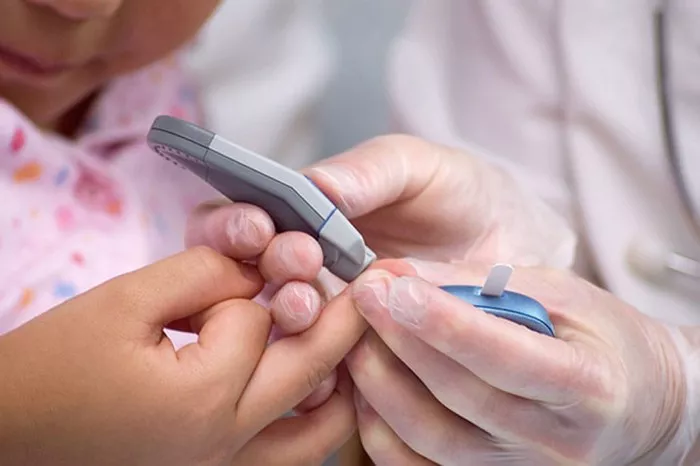Type 1 diabetes is a chronic autoimmune condition that requires continuous management, primarily through insulin therapy, diet, and regular blood sugar monitoring. For individuals with Type 1 diabetes, everyday life involves a careful balance of these elements. However, when a person with Type 1 diabetes falls ill, managing the condition becomes more challenging. Sick days can trigger significant fluctuations in blood glucose levels, increasing the risk of both hyperglycemia (high blood sugar) and hypoglycemia (low blood sugar).
This article provides a comprehensive guide on how to manage Type 1 diabetes during sick days, emphasizing the importance of proactive care, frequent blood glucose monitoring, and adjustments to insulin therapy. By following these guidelines, individuals with Type 1 diabetes can minimize the risks associated with illness and maintain better control over their blood sugar levels during periods of illness.
Why Sick Days Are Different for People with Type 1 Diabetes
When someone with Type 1 diabetes becomes ill, their body responds by releasing stress hormones such as cortisol and adrenaline. These hormones trigger the liver to release more glucose into the bloodstream, leading to elevated blood sugar levels. Infections, fevers, colds, flu, stomach viruses, or even minor illnesses like sore throats can cause blood glucose levels to become unpredictable.
At the same time, illnesses that reduce appetite or cause vomiting and diarrhea can make it difficult to maintain adequate carbohydrate intake, leading to low blood sugar. As a result, the balance between insulin, food, and activity is disrupted. Without proper management, this can lead to dangerous complications such as diabetic ketoacidosis (DKA), a life-threatening condition that occurs when the body starts breaking down fat at an excessive rate, resulting in the production of ketones.
Key Steps to Take During Sick Days
To prevent complications and ensure proper management of blood glucose levels during sick days, it is important to follow a specific set of guidelines. These recommendations involve close monitoring of blood sugar levels, adjusting insulin doses, staying hydrated, and taking necessary steps to prevent the onset of DKA.
1. Monitor Blood Sugar Levels More Frequently
Frequent Blood Glucose Monitoring Is Essential
When you are sick, it is crucial to monitor your blood sugar levels more frequently than usual. Illness can cause blood sugar levels to fluctuate rapidly, making it difficult to predict whether you will experience hyperglycemia or hypoglycemia. The American Diabetes Association (ADA) recommends checking your blood sugar levels at least every 2-4 hours during illness, even at night.
Hyperglycemia Risk: During illness, the body may produce more glucose due to stress hormones, leading to hyperglycemia. Regular monitoring will help identify rising blood sugar levels early so that appropriate action can be taken.
Hypoglycemia Risk: Vomiting, diarrhea, or a reduced appetite can lead to hypoglycemia, especially if insulin doses are not adjusted. Monitoring helps prevent dangerous drops in blood sugar.
Ketone Testing: In addition to blood glucose testing, it is important to check for ketones in the urine or blood if blood glucose levels are consistently above 240 mg/dL. High levels of ketones are a sign that the body is breaking down fat for energy, which can lead to DKA.
2. Adjust Insulin Dosages as Needed
Insulin Adjustments May Be Necessary During Illness
On sick days, your usual insulin doses may need to be adjusted to account for changes in blood sugar levels. It is essential to continue taking insulin, even if you are not eating as much as usual. Skipping insulin can lead to dangerous spikes in blood sugar and an increased risk of DKA.
Basal Insulin: Continue taking your basal (long-acting) insulin as prescribed. Your body still needs this background insulin, even if you are not eating. If you are experiencing high blood sugar, your healthcare provider may recommend temporarily increasing your basal insulin dose.
Bolus Insulin: You may need to adjust your bolus (rapid-acting) insulin doses depending on your blood sugar readings and food intake. If blood sugar levels are consistently high, you may need to take corrective doses of bolus insulin to bring your blood sugar back into target range.
Sick Day Protocols: Work with your healthcare provider to develop a “sick day plan” that includes specific insulin dose adjustments based on your blood sugar levels, ketone levels, and symptoms. Having a clear plan in place can reduce the stress and uncertainty of managing Type 1 diabetes during illness.
3. Stay Hydrated
Proper Hydration Helps Prevent Dehydration and DKA
Staying hydrated is crucial for managing Type 1 diabetes during sick days. When you are ill, especially with symptoms such as vomiting, diarrhea, or fever, dehydration can occur quickly. Dehydration can worsen high blood sugar levels and increase the risk of DKA.
Fluids: Drink plenty of fluids to stay hydrated. Water is the best choice, but you may also need to drink fluids that contain carbohydrates (such as broth, sports drinks, or juice) if you are not able to eat solid food.
Electrolytes: If vomiting or diarrhea is severe, electrolyte replacement drinks may be necessary to replenish lost electrolytes and prevent dehydration.
Small Sips: If you are having difficulty keeping fluids down, try taking small sips frequently rather than large amounts at once.
4. Maintain Carbohydrate Intake
Carbohydrates Are Necessary to Balance Insulin
It can be challenging to eat when you are feeling sick, but it is important to maintain some carbohydrate intake to prevent hypoglycemia, especially if you are taking insulin. Even if you do not feel like eating your usual meals, try to consume small amounts of easily digestible carbohydrates to help keep your blood sugar stable.
Simple Carbohydrates: If solid food is difficult to tolerate, opt for simple carbohydrates that are easy on the stomach, such as crackers, applesauce, or toast. These foods can provide the necessary glucose to prevent hypoglycemia.
Liquids with Carbohydrates: If you are unable to eat solid foods, drink fluids that contain carbohydrates, such as fruit juice, regular (non-diet) soda, or oral rehydration solutions. These can help prevent blood sugar from dropping too low.
5. Monitor for Signs of Diabetic Ketoacidosis (DKA)
Know the Symptoms of DKA and Seek Medical Attention if Needed
Diabetic ketoacidosis (DKA) is a serious complication of Type 1 diabetes that occurs when the body breaks down fat for energy in the absence of sufficient insulin. This process results in the production of ketones, which can build up in the blood and cause the blood to become acidic. DKA can be life-threatening and requires immediate medical attention.
Symptoms of DKA: The symptoms of DKA include high blood sugar (above 240 mg/dL), the presence of ketones in the urine or blood, nausea and vomiting, abdominal pain, difficulty breathing, fruity-smelling breath, confusion, and fatigue.
Ketone Testing: As mentioned earlier, if your blood sugar is consistently above 240 mg/dL, it is important to test for ketones using urine or blood ketone test strips. High ketone levels are a warning sign of impending DKA.
Seek Medical Help: If you suspect you have DKA, seek medical attention immediately. DKA requires hospitalization and intravenous fluids, insulin, and electrolytes to correct the metabolic imbalance.
6. When to Call Your Healthcare Provider
Stay in Contact with Your Healthcare Team
During sick days, it is important to stay in close contact with your healthcare provider. They can provide guidance on how to adjust your insulin doses, manage your symptoms, and prevent complications. You should call your healthcare provider if:
- You have persistent high blood sugar levels (above 240 mg/dL) that do not respond to corrective insulin doses.
- You have moderate to high levels of ketones in your urine or blood.
- You are unable to keep food or fluids down for more than 24 hours.
- You are experiencing symptoms of DKA, such as nausea, vomiting, abdominal pain, or difficulty breathing.
- You are unsure how to adjust your insulin doses or manage your symptoms.
7. Plan Ahead for Sick Days
Prepare a Sick Day Kit and Plan
Being prepared for sick days can reduce stress and help you manage your Type 1 diabetes more effectively. Here are some tips for preparing for sick days:
Sick Day Kit: Assemble a sick day kit that includes items such as blood glucose test strips, ketone test strips, insulin (basal and bolus), a thermometer, electrolyte replacement drinks, simple carbohydrates (e.g., crackers, applesauce), and any other supplies recommended by your healthcare provider.
Sick Day Plan: Work with your healthcare provider to develop a personalized sick day plan that outlines how to adjust your insulin doses, when to check your blood sugar and ketones, and when to seek medical help.
Medication Stock: Make sure you have an adequate supply of insulin, test strips, and other medications to last through your illness. Running out of supplies during a sick day can make diabetes management much more difficult.
8. Rest and Take Care of Yourself
Give Your Body Time to Recover
Rest is an important part of recovering from illness. While it is crucial to stay vigilant about blood sugar monitoring and insulin adjustments, it is equally important to allow your body to rest and recover. Stress can exacerbate illness and make blood sugar management more challenging, so take the time to relax and recuperate.
9. Know When to Go to the Hospital
Emergency Care May Be Necessary in Some Cases
If your symptoms worsen despite your best efforts to manage your blood sugar and ketones at home, it may be necessary to seek emergency medical care. Go to the hospital or emergency room if:
- You are unable to keep fluids down and are becoming dehydrated.
- You have severe symptoms of DKA, such as confusion, vomiting, rapid breathing, or severe abdominal pain.
- Your blood sugar remains dangerously high (above 300 mg/dL) despite taking corrective insulin doses.
See also: What is the Fastest Way to Reverse Diabetes?
Conclusion
Managing Type 1 diabetes during sick days requires careful monitoring of blood glucose levels, ketone testing, adjustments to insulin therapy, and staying hydrated. By following a sick day plan and being prepared, you can minimize the risks associated with illness and prevent complications such as DKA. It is essential to stay in close contact with your healthcare provider and seek medical help if your symptoms worsen. With proper care and attention, you can safely navigate sick days while living with Type 1 diabetes.
Related topics:
What Are the Causes of Childhood Diabetes?



























